1 min read
Herbig-Haro 49/50 (NIRCam and MIRI Image)
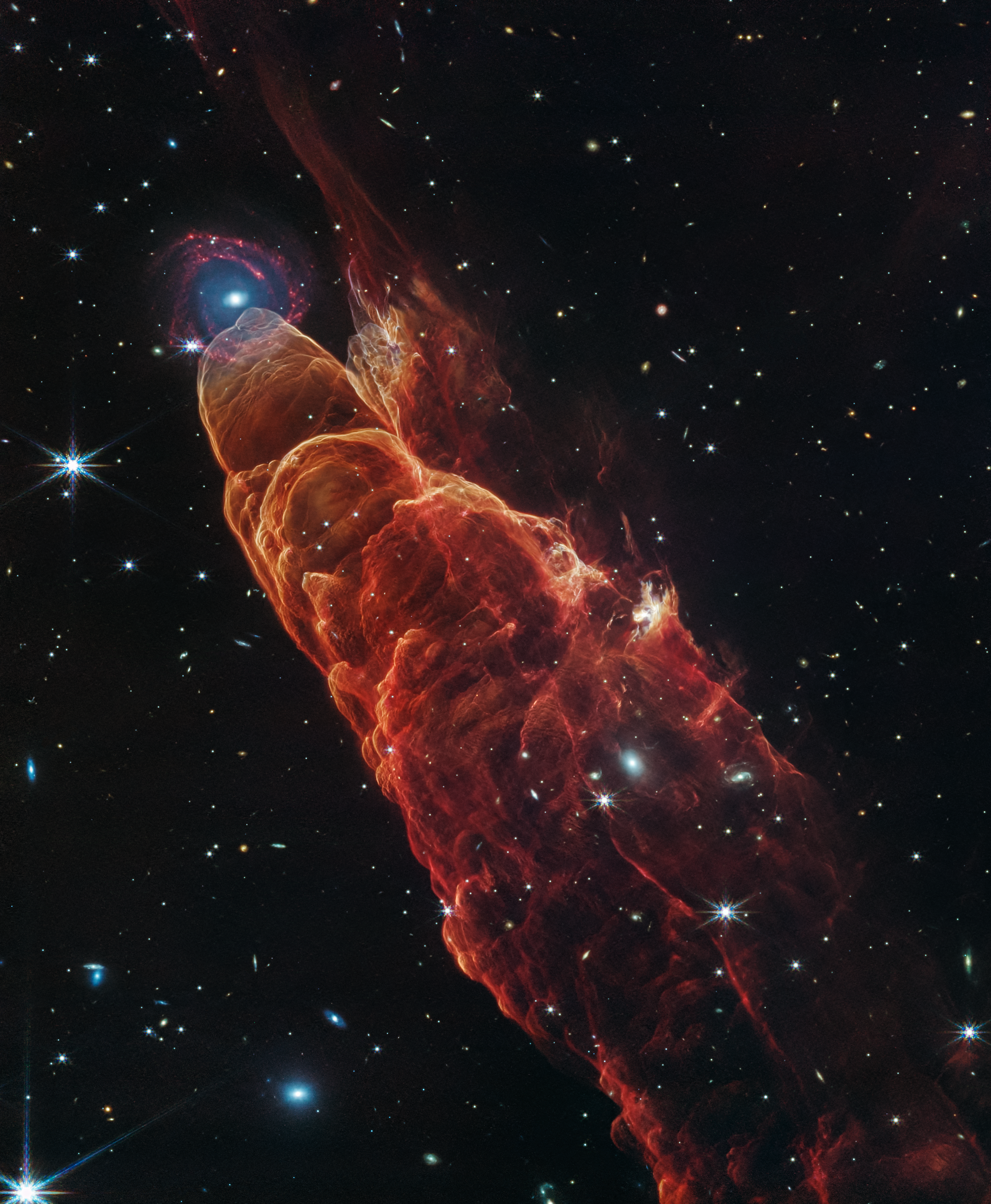
NASA’s James Webb Space Telescope observed Herbig-Haro 49/50, an outflow from a nearby still-forming star, in high-resolution near- and mid-infrared light. The young star is off to the lower right corner of the Webb image.Intricate features of the outflow, represented in reddish-orange color, provide detailed clues about how young stars form and how their jet activity affects the environment around them. A chance alignment in this direction of the sky provides a beautiful juxtaposition of this nearby Herbig-Haro object (located within our Milky Way) with a face-on spiral galaxy in the distant background.
Protostars are young stars in the process of formation that generally launch narrow jets of material. These jets move through the surrounding environment, in some cases extending to large distances away from the protostar.
Like the water wake generated by a speeding boat, the arcs in this image are created by the fast-moving jet slamming into surrounding dust and gas. This ambient material is compressed and heats up, then cools by emitting light at visible and infrared wavelengths. In particular, the infrared light captured here by Webb highlights molecular hydrogen and carbon monoxide.
The galaxy that appears by happenstance at the tip of Herbig-Haro 49/50 is a much more distant spiral galaxy. It has a prominent central bulge represented in blue that shows the location of older stars. It also displays hints of “side lobes,” suggesting that this could be a barred-spiral galaxy. Reddish clumps within the spiral arms show the locations of warm dust and groups of forming stars.
There are many more galaxies at further distances in the surrounding background, including ones that shine through the diffuse infrared glow of the nearby Herbig-Haro object.
About the Object
- R.A. PositionR.A. PositionRight ascension – analogous to longitude – is one component of an object's position.11:05:56.2
- Dec. PositionDec. PositionDeclination – analogous to latitude – is one component of an object's position.-77:33:31.7
- ConstellationConstellationOne of 88 recognized regions of the celestial sphere in which the object appears.Chamaeleon
- DistanceDistanceThe physical distance from Earth to the astronomical object. Distances within our solar system are usually measured in Astronomical Units (AU). Distances between stars are usually measured in light-years. Interstellar distances can also be measured in parsecs.625 light-years
- DimensionsDimensionsThe physical size of the object or the apparent angle it subtends on the sky.Image is 2.13 arcmin across (about 0.3 light-years)
About the Data
- Data DescriptionData DescriptionProposal: A description of the observations, their scientific justification, and the links to the data available in the science archive.
Science Team: The astronomers who planned the observations and analyzed the data. "PI" refers to the Principal Investigator.This image was created with Webb data from proposal: 6558 (M. Garcia Marin). Image processing: Joseph DePasquale (STScI).
- InstrumentInstrumentThe science instrument used to produce the data.NIRCam, MIRI
- Exposure DatesExposure DatesThe date(s) that the telescope made its observations and the total exposure time.06 August 2024
- FiltersFiltersThe camera filters that were used in the science observations.NIRCam: F200W, F335M, F444W, F470N; MIRI: F770W
- Object NameObject NameA name or catalog number that astronomers use to identify an astronomical object.Herbig-Haro 49/50, HH 49/50
- Object DescriptionObject DescriptionThe type of astronomical object.Stellar Jets
- Release DateMarch 24, 2025
- Science ReleaseNASA’s Webb Telescope Unmasks True Nature of the Cosmic Tornado
- CreditImage: NASA, ESA, CSA, STScI

These images are a composite of separate exposures acquired by the James Webb Space Telescope using the NIRCam and MIRI instruments. Several filters were used to sample specific wavelength ranges. The color results from assigning different hues (colors) to each monochromatic (grayscale) image associated with an individual filter. In this case, the assigned colors are: Red: F770W, Orange: F470N, Green: F444W, Cyan: F335M, Blue: F200W
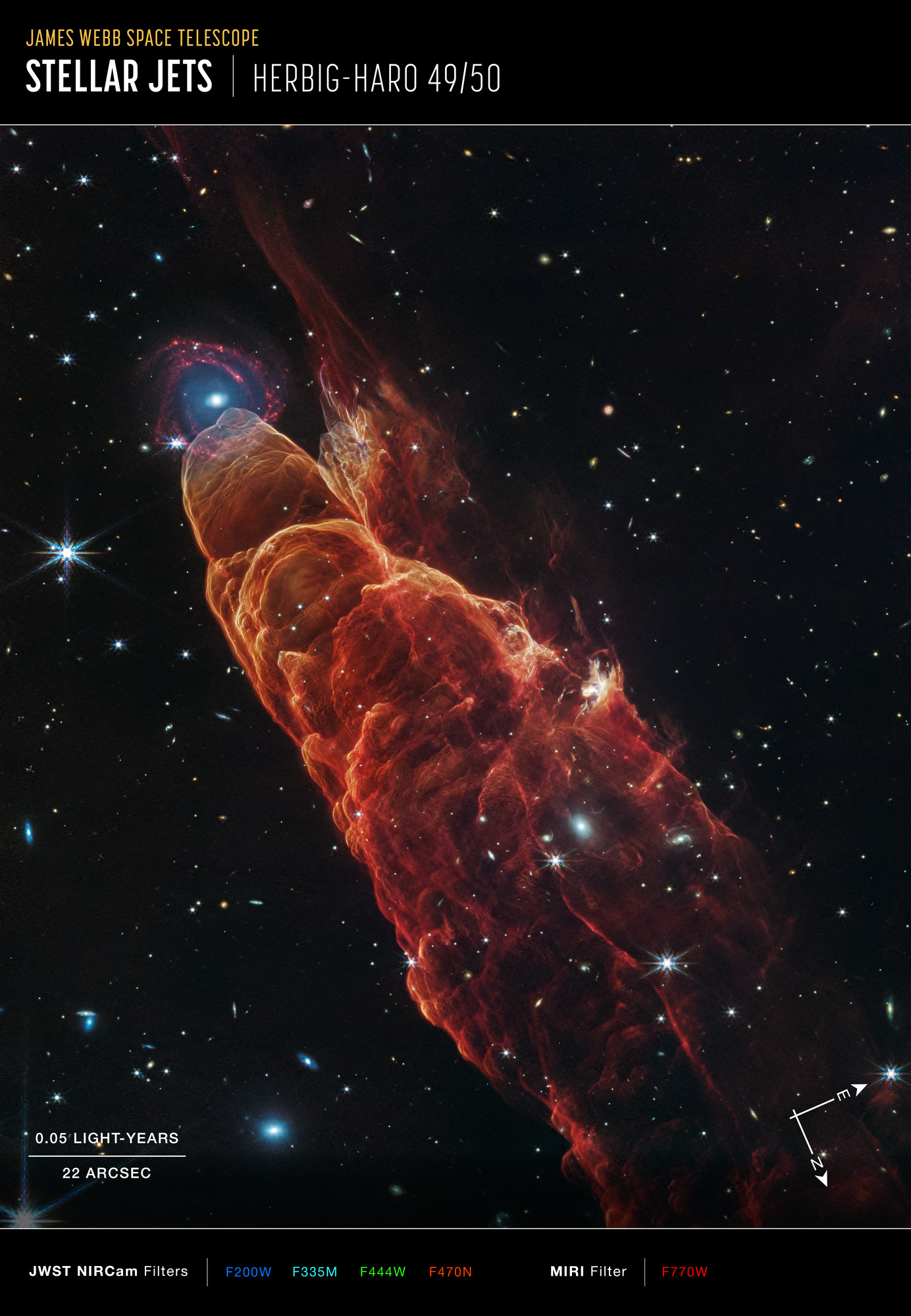
Related Images & Videos
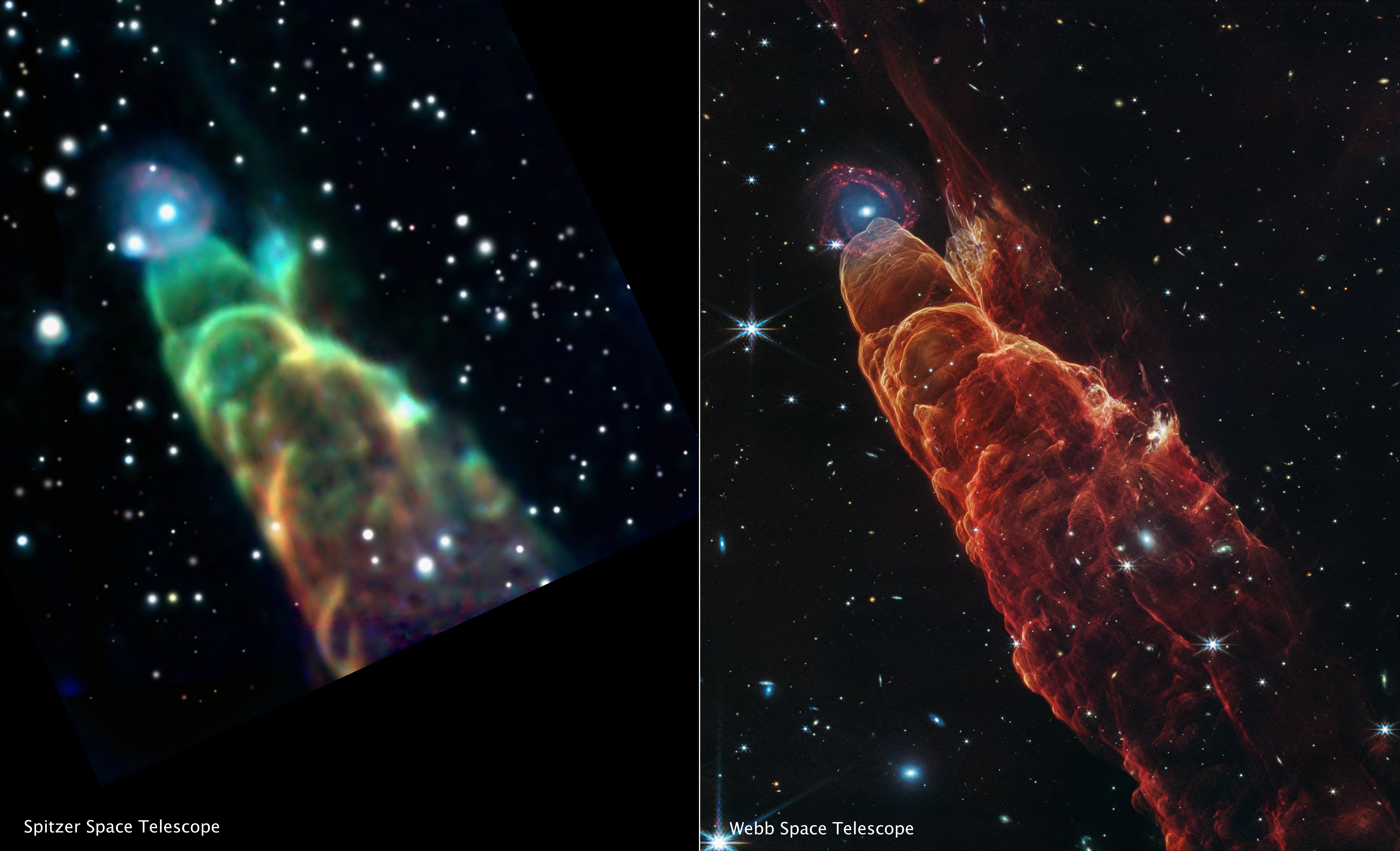
Herbig-Haro 49/50 (Spitzer and Webb Images)
This side-by-side comparison shows a Spitzer Space Telescope image of HH 49/50 (left) versus a Webb image of the same object (right) using the NIRCam (Near-infrared Camera) instrument and MIRI (Mid-infrared Instrument). The Webb image shows intricate details of the heated gas...
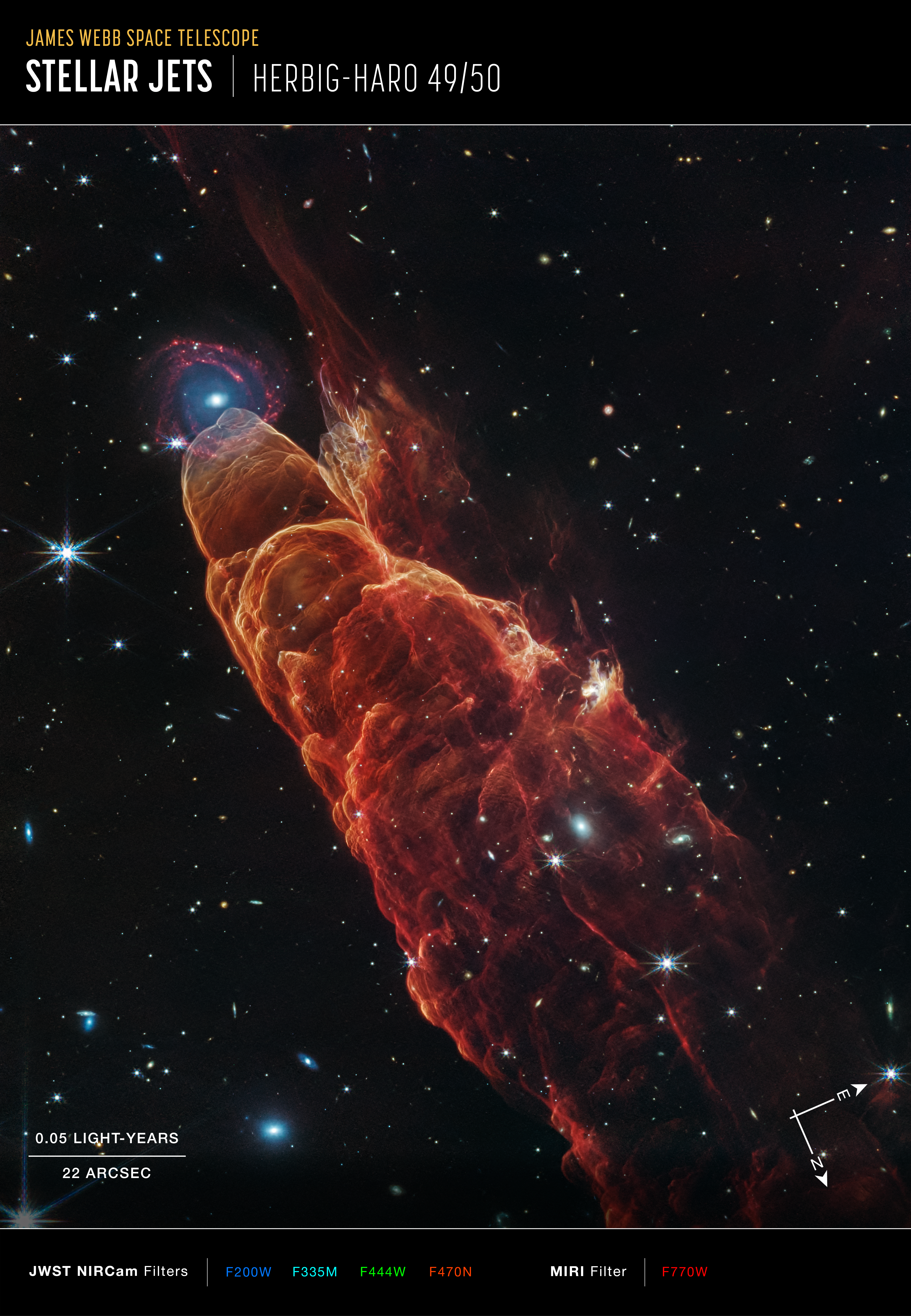
Herbig-Haro 49/50 (NIRCam and MIRI Compass Image)
This image of Herbig-Haro 49/50, captured by the James Webb Space Telescope’s NIRCam (Near-Infrared Camera) and MIRI (Mid-Infrared Instrument), shows compass arrows, scale bar, and color key for reference. The north and east compass arrows show the orientation of the image on...
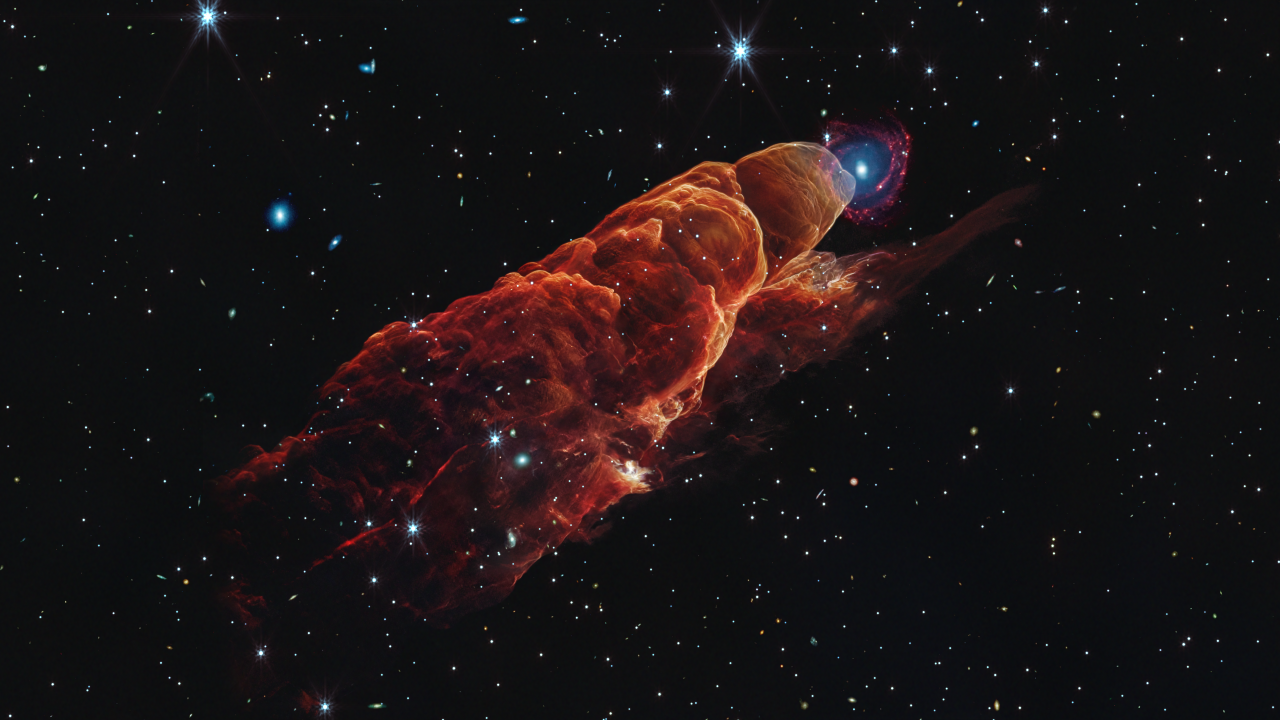
Herbig-Haro 49/50 Stellar Jets
This visualization examines the three-dimensional structure of Herbig-Haro 49/50 (HH 49/50) as seen in near- and mid-infrared light by the James Webb Space Telescope. HH 49/50 is an outflow produced by the jet of a nearby still-forming star in the Chamaeleon I Cloud complex, one...
Share
Details
Laura Betz
NASA’s Goddard Space Flight Center
Greenbelt, Maryland
laura.e.betz@nasa.gov
NASA, ESA, CSA, STScI































